Quantum Oscillations and Chiral Anomaly in a Bi0.96Sb0.04 Single Crystal
Abstract
Bi1-xSbx alloys are of special significance in topological insulator research. Here we focus on the Bi0.96Sb0.04 alloy in which the conduction band edge just touches the valence band edge. Transport measurements show quantum oscillations in the longitudinal (Shubnikov–de Haas effect) and transverse magnetoresistance originating from a spheroidal Fermi surface pocket. Further investigation of the longitudinal magnetoresistance for the magnetic field parallel to the electrical current shows a small nonmonotonic magnetoresistance that is attributed to a competition of weak-antilocalization effects and a topological term related to the chiral anomaly.
1. Introduction
Being the first experimentally confirmed 3D topological insulator [1, 2], Bi1-xSbx alloys have attracted much attention in the past decade. The band structure of Bi1-xSbx alloys shows that when the Sb concentration is within the range x = 0.07-0.22, there is a gap between the inverted La band and Ls band. The inverted band structure results in an insulating bulk and conducting surface states, with a Dirac cone energy dispersion preserved by a nontrivial topological quantum number [3–5]. The alloy’s physical properties are very sensitive to the percentage of Sb, and the evolution of the band structure and topological properties are studied over a wide Sb concentration range [6]. A special point of interest is x = 0.04, where the valence band and conduction band just touch each other forming a Dirac cone. Hence, Bi0.96Sb0.04 may show properties originating from Dirac fermions.
Here we report a magnetotransport study taken on a single crystalline Bi1-xSbx alloy at the Weyl point composition Bi0.96Sb0.04. We have investigated the electronic structure at the Fermi surface via magnetoresistance and quantum oscillations and report the effect of the chiral anomaly.
2. Experimental Details
A single crystal (SC) Bi0.96Sb0.04 is synthesized using a modified Bridgman method in a cone-shaped quartz tube with starting materials high purity Bi (5N) and Sb (6N). The transport properties were measured using a standard six-point contact configuration in a Physical Property Measurement System (PPMS) of Quantum Design, in applied magnetic fields up to 9 T. The size of the magnetotransport crystal is length×width×thickness = 6.1×2.8×1.5 mm3, and the voltage and current contacts were made on the cleaved (111) plane. The crystal was mounted on a horizontal rotation stage, which allowed to vary the angle between the magnetic field and sample surface. Different crystals taken from the same Bi0.96Sb0.04 batch showed overall a very good consistency in the measured transport properties.
3. Basic Transport Properties
The basic transport properties of SC Bi0.96Sb0.04 are shown in Figure 1. The resistance measured in the temperature range 2-300 K is semiconducting-like down to 120 K and then becomes metallic-like at lower temperatures, as shown in panel (a). The longitudinal resistance Rxx (MR) and transverse or Hall resistance Rxy (HR) were measured in magnetic fields up to 9 T at several temperatures. The data were (anti)symmetrized by measuring Rxx and Rxy for both polarities of the magnetic field, thus compensating for the possible misalignment of the voltage contacts. The magnetoresistance is reported in Figure 1(b). The curves show that the MR bears many characteristic features, such as the weak-antilocalization effect (WAL) at low magnetic field, large and nonsaturated linear magnetoresistance in the high field range, and quantum oscillations below 20 K. These are all hot topics in the research on topological materials nowadays [20–22]. The carrier density and the mobility of the crystal derived after symmetrizing the data are shown in Figure 1(c). The charge carriers change from hole type to electron type as the temperature is increased to above 200 K. The carrier mobility is as high as 1.7 m2/Vs at 2 K and exhibits a gradual decrease with increasing the temperature. This behavior is similar to that observed in conventional semimetals and semiconductors.
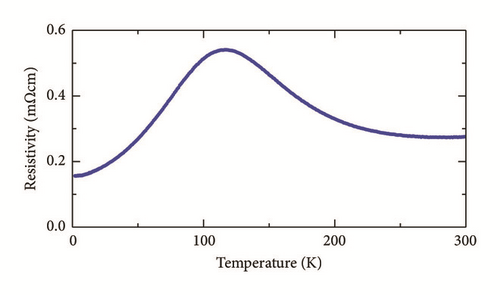
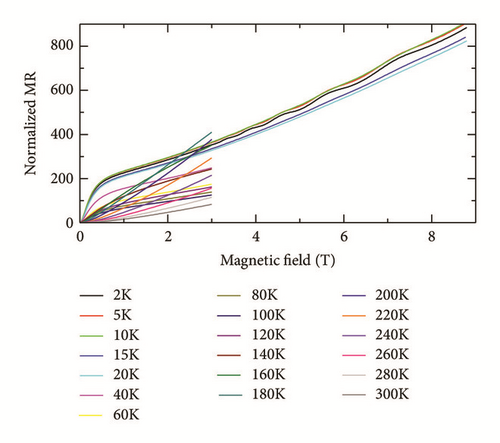
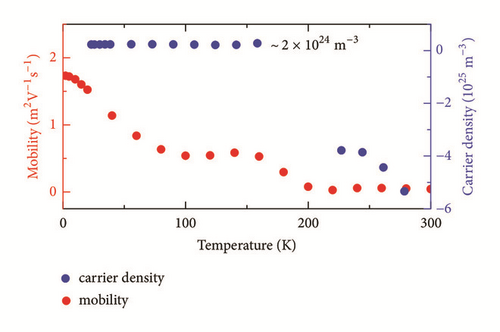
Next we discuss the Shubnikov–de Haas (SdH) effect. By subtracting a smooth polynomial function as background of the MR(B)-curves in Figure 1(b), we obtain the oscillatory part of the magnetoresistance (δMR). δMR is plotted in Figure 2(a) against the inverse of the magnetic field and its periodic nature shows it is a SdH oscillation. The Fast Fourier Transform (FFT) gives a frequency f = 20 ± 2 T. Besides the SdH effect in Rxx, we also observed quantum oscillations in Rxy (raw data not shown); see Figure 2(b). A FFT of δHR shows the same frequency as in Rxx within the experimental error. Since we have properly symmetrized the data, the oscillation in δHR is a genuine effect, which is furthermore demonstrated by the fact that the oscillations in δMR and δHR are in antiphase [23]. The observation of quantum oscillations in the Hall resistance in Bi compounds is not uncommon [24].
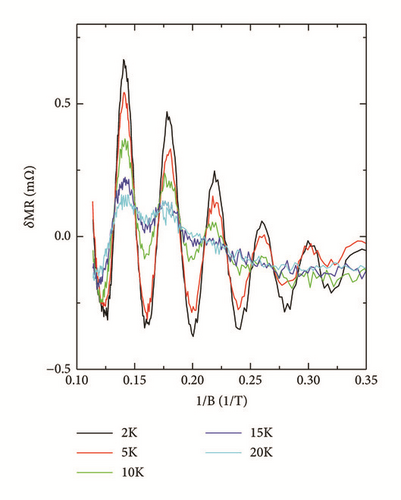
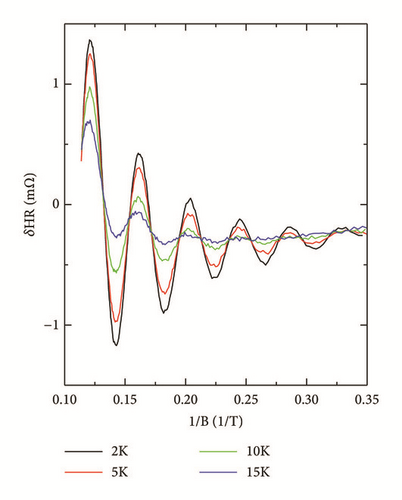
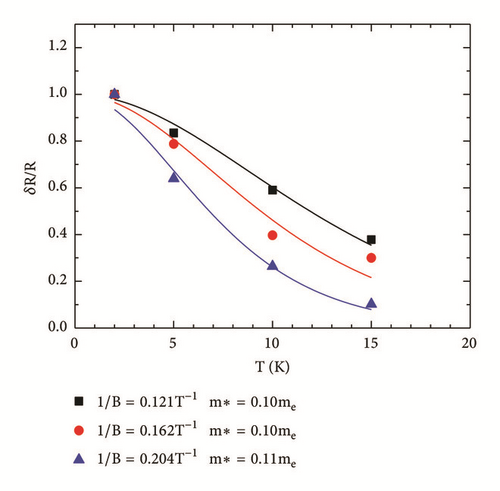
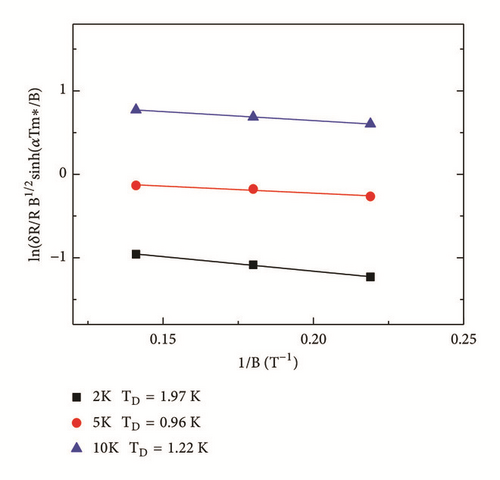
The derived effective carrier mass m∗ is 0.10-0.11me, while the Dingle temperature falls in the range 0.96-1.97 K, with an averaged value 1.38 K. From the Dingle temperature another important parameter can be obtained, namely, the quantum lifetime τD, since TD=ħ/2π kB τD. We estimate τD = 8.81×10−13 s, which results in a mobility μ = 15186 cm2/Vs. This value is consistent with the one we calculated from the Hall effect shown in Figure 1(c).
Since the Bi1-xSbx alloy, for a certain range of x-values, could be a topological insulator, the electronic transport of the sample may be due to surface Dirac electrons [26]. To investigate this the angular variation of the magnetoresistance has been measured. Figure 4(a) shows the field dependence of the MR at various angles, where θ is the angle between the magnetic field and the sample surface. The experiment was realized by tilting the sample holder gradually in the magnetic field as shown in the schematic drawing in Figure 4(a). It is important to notice that the direction of the magnetic field B is always kept perpendicular to the electrical current I, while tuning the angle θ.
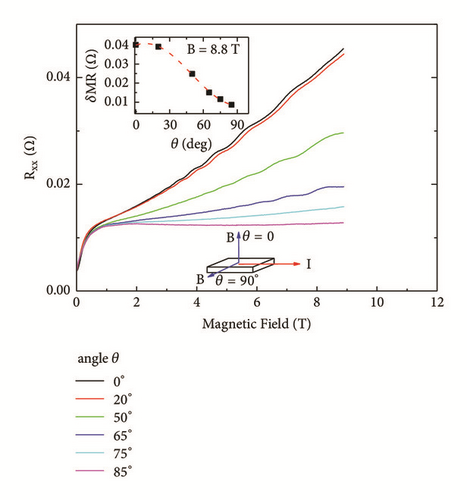
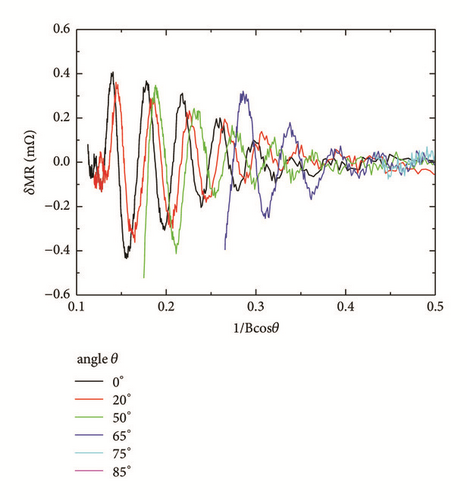
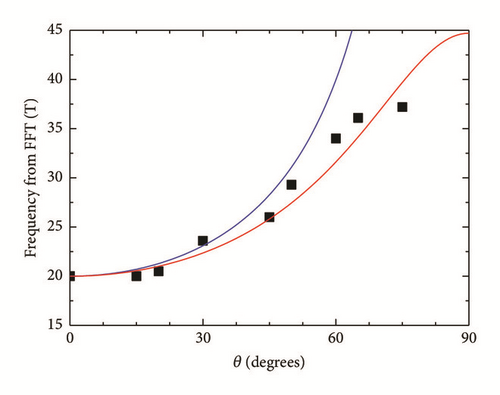
After subtracting the background we obtained the SdH signal, which is plotted in Figure 4(b) as a function of 1/( B cos θ). The period evolves with 1/(B cos θ), which shows that the SdH signal does not originate from surface states with a 2D Fermi surface. In Figure 4(c) the frequencies are plotted as a function of θ. Here we also compare the data with the theoretical curves for a cylindrical Fermi surface (blue line) and a bulk spheroidal Fermi surface (red line). A reasonable agreement can be obtained by assuming a spheroidal hole pocket with a major half axis of 5.6×108 m−1 and minor half axis of 2.5×108 m−1.
4. Chiral Anomaly
Next we rotate the magnetic field from ‘parallel to’ the current I to ‘perpendicular to’ the current and sample surface, which reveals another interesting behavior. Selected magnetoresistance curves obtained at a temperature of 2 K for 75° < θ < 105° are shown in Figure 5. Here θ is the rotation angle of the magnetic field with θ = 0 for B ⊥ I and θ = 90° for B ∥ I; see the schematic drawing in Figure 5. When the magnetic field is close to ‘parallel to’ the current we observe a number of features. At very low fields the positive magnetoresistance is due to WAL, but then an oscillatory behavior sets in with a local maximum around 1 T and a deep minimum around 1.5 T. The oscillatory behavior is systematic for a field tilt up to ±5° with respect to the current and extends up to 9 T. Obviously it is not a SdH oscillation which is periodic in 1/B. The small magnetoresistance for B ∥ I is most likely associated with the chiral anomaly. The modest MR values seem to result from the competition between the negative magnetoresistance and the strong WAL. This effect is only observed for field angles close to the current. For larger tilt angles, e.g., θ = 75°, 100°, and 105°, the MR is large and positive. Similar features in the MR of Bi0.97Sb0.03 have been reported by Kim et al. [19, 27]. These authors analyzed the conductivity data with a simple model with Drude, WAL, and topological (E · B term) contributions and also concluded that the (negative) MR could be the result of the competition between WAL and the chiral anomaly term. We remark that the magnetoresistance of pure Bi does not show the anomalous behavior related to the chiral anomaly as shown in the inset of Figure 5. Recently, Gorba et al. [28] have evaluated the magnetoconductivity tensor of Dirac and Weyl semimetals with the Kubo’s linear response theory and also found an oscillatory behavior in magnetic field, but here it is related to the SdH effect. It is still a challenging task to solve the negative MR theoretically as a consequence of the chiral anomaly.
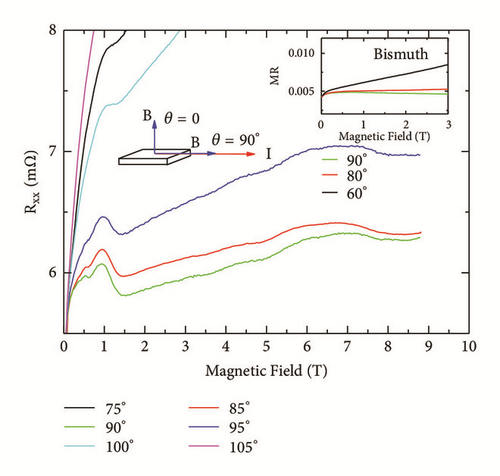
5. Summary
In summary, we have studied the magnetotransport properties of a Bi1-xSbx single crystal with x = 0.04, i.e., the concentration for which a Dirac point is expected in the bulk band structure. SdH oscillations are found in the longitudinal and transverse magnetoresistance with f = 20±2 T. These are attributed to a 3D spheroidal Fermi surface. Magnetoresistance experiments for the field along the current direction show a small magnetoresistance with unusual oscillatory behavior. This is attributed to a competition between WAL and the effect of the chiral anomaly due to Weyl points.
Conflicts of Interest
The authors declare that they have no conflicts of interest.
Acknowledgments
We would like to thank the National Science Foundation of China, the youth fund 51601068. This work was part of the research program on Topological Insulators of FOM (Dutch Foundation for Fundamental Research on Matter). The authors are grateful to Mark Golden, Yu Pan, Weidong Zou, and Qiubao Lin for useful discussions.
Open Research
Data Availability
The data used to support the findings of this study are available from the corresponding author upon request.




